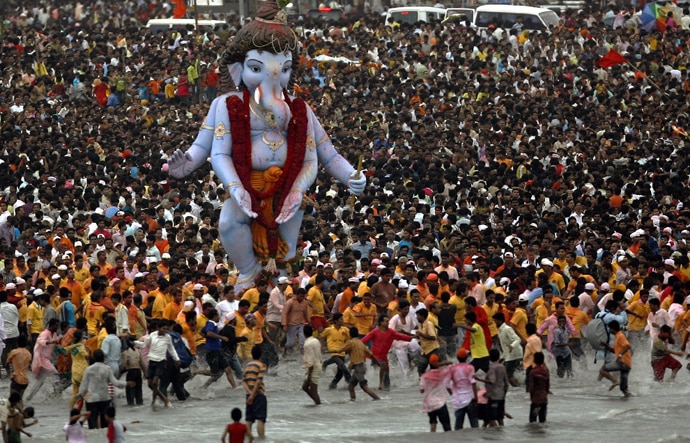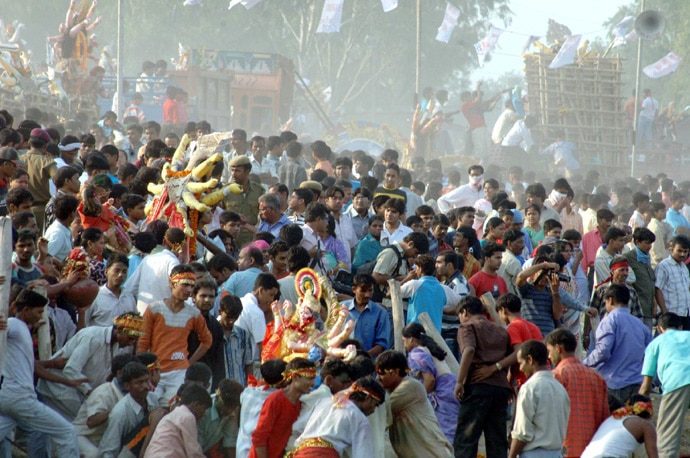Keep your streets off my festival

Dr Mahesh Bedekar comes from a family of Thane’s most illustrious doctors. A gynaecologist at one of the busiest wards in the city with a population of 18 lakhs as per the 2011 census, located in the heart of the old city’s residential area, you can imagine the demands of procession after procession on patient after patient. His previous PIL forced pandals to stop short of restricting traffic. His current PIL which alleges no action by authorities even on complaints, has pushed the Bombay High Court to state that taking festivals to streets is not a fundamental right. There is no argument against Dr Bedekar’s plea that festivals on the streets today are nothing but a public nuisance – they have become a bunch of drunken louts in most part dancing to music that is not remotely an expression of devotion, and a money collecting racket by local gangs of politically connected goons. One would, if one was so inclined to spontaneous outbursts of delirium, hug the good doctor for his efforts.
However, when the honourable High Court said six days ago: “According to the order, no citizen can claim fundamental right to worship God or offer prayer at any and every place, unless it is a significant place of worship”, it is pertinent to point out that the court is taking on the function of the British Empire which the Ganesh festival was begun to counter, in the first place.
Lokmanya Tilak was a Hindu nationalist who apart from raising two of the celebrated idols that linger in Maharashtra today – Ganesha and Chattrapati Shivaji –as a unifying force to counter casteist differences between the masses, also pioneered nationalistic journalism in India. The Kesari and Maratha were a counter to the English language press’s adherence to the coloniser-commanded of expression and demanded self rule from the start. His "Has the government lost its head?" – unheard of words in the worthies that claim ancestry of nearly 200 years in journalism today – landed Tilak in jail.
 |
| Ganesh Chaturthi festival in Mumbai. |
In an age when Indian identity was being wilfully eclipsed by the Western, the founder of Swarajya played a role crucial to the self esteem of the freedom movement. But he also opposed the Age of Consent bill in 1891, that sought to raise the age of marriage from 10 years to 12, when it was already 16 in Britain reasoning that the British should not interfere in local customs. Luckily, he was overruled. A reformer nevertheless, he gave us a mixed bag of legacies. He was the first Congress leader to suggest Hindi as a national language; one that would transcend our linguistic divides in States. His overall thrust was towards a mass homogenisation of the diversity that was India. In this he stood opposed to Nehru’s leaning towards diversity: he believed it was necessary to unite first in order to oppose. The symbols he used – Shivaji and Ganesh – were means to achieve this.
In 1893, when Tilak took Ganesha out of private pandals and installed large figurines on public roads to call all to prayer he was performing two key services.
The first was to discover and eliminate the caste differences between Hindus that he found were obstructing the unification of people against the British. He was seeking India’s common ground. Secondly, he was exploiting a loophole in the British orders against congregations of Indians. After the First War of Independence, the British had vowed not to interfere in local religious activity. Tilak ingeniously surmised that to assemble under the guise of Ganesh festivals was a ploy the British would not thwart. Bengal’s Kali pujas similarly took on these two functions. The Keshavji Naik Chawl in Mumbai continues to observe a minimalistic, sparse version of the festival in honour of being the first to respond to Tilak’s call.
The congregation of people under these symbols then become tools of our freedom. Our right to assembly and our right to unity against. Why does India pray publicly? We do so because it is what saved us from being broken into individual units that failed to acquire the might to throw off a colonial burden. It reminds us that we achieved this only by discarding our differences of caste, class, Brahmin with Dalit, meat-eater with non-meat-eater. The Muslim who occupies Mumbai’s streets during Ramzan reminds us of his presence and his equally valid needs, as the cowherd climbers of Dahi handi. It is vital to the cosmopolitanism of this city that these markers stay in place.
Tilak’s vision was that whatever you might be on your own, in your personal space, collectively for a few minutes every day, using God as guise if you will, we become Indian.
In times like these, when riots break out, when beef eater cannot stand the onion-discarder, and the Hindu-Muslim equation is at the mercy of political sentiment, it is crucial that the courts do not hijack the symbolism of public unity.
 |
| Procession during Durga puja in Kolkata. |
The failure is not of the people but of the State : its inability to police regulations as basic as noise levels, licences, public disorderliness, the erection of pandals in public spaces, traffic, or tend to complaints.The solution to these is not to ban, again, the Indian public’s right to congregation under a symbol, but in terms of governance, to regulate how these symbols are used, and in terms of social awareness, reclaim what these symbols have come to represent.
And Tilak and the British were right. Interference in religious celebrations are not the domain of the State and are to be avoided at all cost.
And who knows when we will need the cover to rally against establishment again?

